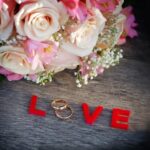Are you in the midst of planning your wedding and wondering how to choose your wedding colors? The colors you choose for your big day can have a significant impact on the overall look and feel of your wedding. From setting the mood to reflecting your personal style, the right color palette can make all the difference. In this article, we will guide you through the process of choosing your wedding colors, from finding inspiration to finalizing your color palette.
One of the first steps in choosing your wedding colors is understanding the significance behind them. Wedding colors go beyond just aesthetics-they can reflect your personality as a couple, convey a particular theme or mood, and even tie into cultural or traditional symbolism. By understanding the deeper meaning behind different colors and combinations, you can ensure that your chosen palette truly resonates with you and adds a meaningful touch to your special day.
Finding inspiration for your wedding color palette can come from various sources-nature, art, fashion, or even your favorite décor styles. Whether it’s a vibrant sunset, a beloved painting, or a trendy color scheme from a runway show, drawing inspiration from different sources can help you narrow down the options and find the perfect hues for your wedding.
Keep reading as we explore different ways to find inspiration for creating a stunning and meaningful color palette for your big day.
Finding Inspiration for Your Wedding Color Palette
Your wedding color palette sets the tone for your entire celebration, so it’s important to find inspiration that truly speaks to you as a couple. Here are some tips on how to choose your wedding colors:
- Look to nature: Consider the season in which you’ll be getting married and take inspiration from the natural colors that are prominent during that time. For a spring wedding, think pastel shades like pink, lavender, and mint green. For a summer wedding, vibrant hues like coral, turquoise, and sunshine yellow can be great choices.
In the fall, rich tones like deep red, burnt orange, and mustard yellow can create a warm and cozy atmosphere. And for winter weddings, consider elegant colors like navy blue, emerald green, and silver. - Consider your venue: The location of your wedding can also provide inspiration for your color palette. If you’re getting married at a beachside resort, you might want to incorporate soft blues and sandy neutrals into your decor. For a rustic barn wedding, earthy tones like brown, cream, and sage green could work well. Think about how you can complement the existing colors of your venue with your chosen palette.
- Take cues from your love story: Your relationship and personal style can also guide you in choosing the perfect wedding colors. If you have special memories associated with certain colors or if there are hues that hold deep meaning for both of you as a couple, incorporating them into your wedding palette can add an extra layer of significance to your celebration.
By finding inspiration from nature, considering your venue, and reflecting on what speaks to you as a couple, you’ll be well on your way to selecting the perfect color palette for your big day. Remember that ultimately it’s about choosing colors that resonate with both of you as individuals and as a couple – after all, it’s your special day.
Considering the Season and Venue for Your Wedding
Once you have an idea of the colors that inspire you, it’s important to consider the season and venue for your wedding when choosing your color palette. The time of year and location of your wedding can greatly influence the colors that will work best and create the perfect atmosphere for your special day.
Seasonal Considerations
If you’re having a spring wedding, pastel shades such as soft pinks, greens, yellows, and blues can be a beautiful choice. For a summer wedding, consider brighter and bolder hues like coral, turquoise, or sunny yellow. Fall weddings often lend themselves to rich, warm colors like deep reds, oranges, and golds. Winter weddings can be complemented by cool tones such as icy blues, silver, and shades of evergreen.
Venue Influence
The venue for your wedding can also help dictate your color choices. If you’re getting married in a rustic barn setting, earthy tones or shades inspired by nature can work well. A beach or waterfront venue might call for soft blues and sandy neutrals. A modern urban space could accommodate bold color choices or sleek metallic accents.
Considering the season and venue for your wedding is crucial in creating a cohesive and visually appealing color palette. By taking these factors into account alongside the colors that inspire you personally, you can ensure that your wedding colors reflect both your style and the setting of your special day.
Exploring Different Color Combinations and Their Meanings
When choosing your wedding colors, it’s important to consider the different color combinations and their meanings. Different colors evoke different emotions and have varying symbolism, so it’s crucial to choose a combination that resonates with you and your partner. Whether you’re drawn to bold and vibrant hues or prefer soft and muted tones, there are endless possibilities when it comes to creating the perfect color palette for your special day.
One popular approach to selecting wedding colors is by considering the meanings associated with different hues. For example, shades of blue are often associated with tranquility and trust, making them a great choice for couples who want to create a sense of calm and stability on their wedding day. On the other hand, vibrant reds can represent passion and love, making them an ideal option for couples who want to infuse their celebration with energy and romance.
Another important factor to consider when exploring different color combinations is how these hues will work together visually. Some combinations may create a striking contrast, while others may offer a more harmonious feel. It’s essential to think about which colors complement each other and how they will be incorporated into various aspects of your wedding, such as attire, decor, and floral arrangements.
Before finalizing your wedding color palette, take the time to research the meanings behind different hues and explore various combinations. By understanding the significance of each color and how they work together visually, you can create a cohesive and meaningful color scheme that sets the tone for your special day.
| Wedding Color | Meaning |
|---|---|
| Blue | Tranquility and trust |
| Red | Passion and love |
Tips for Incorporating Your Wedding Colors Into Every Aspect of Your Big Day
Once you have chosen your wedding colors, the next step is to incorporate them into every aspect of your big day. The key is to create a cohesive and visually appealing look that ties everything together. From the invitations to the decor, here are some tips on how to seamlessly infuse your chosen colors into your wedding:
When it comes to incorporating your wedding colors, start with the invitations. Use your chosen colors in the design and printing of your save-the-dates, invitations, and other stationery. This will set the tone for your guests and give them a glimpse of what to expect on your wedding day.
Another important aspect to consider is the bridal party attire. Whether it’s the bridesmaid dresses, groomsmen accessories, or flower arrangements, make sure they all complement and enhance your chosen color palette. This will create a visually stunning effect during the ceremony and in photos.
In terms of decor, think about how you can integrate your wedding colors into the venue space. This can be through table linens, floral arrangements, lighting, signage, and even small details like napkins or favors. Being intentional with these elements will result in a polished and harmonious ambiance for your celebration.
| Aspect | Tip |
|---|---|
| Invitations | Use chosen colors in save-the-dates & invites |
| Bridal Party Attire | Complement each outfit with color palette |
| Decor | Integrate colors through table linens & floral arrangements |
The Psychology Behind Popular Wedding Colors
When it comes to choosing the perfect colors for your wedding, it’s important to consider the psychology behind popular wedding colors. Each color has its own meaning and can evoke certain emotions, making it essential to choose hues that not only look beautiful but also reflect the mood you want for your special day.
Understanding the Meaning of Popular Wedding Colors
Before deciding on your wedding colors, it’s helpful to understand the meanings commonly associated with different hues. For example, red is often linked to love and passion, while blue is associated with tranquility and stability. By having a grasp of these associations, you can select colors that align with the ambiance you wish to create at your wedding.
Creating an Emotional Atmosphere
Certain colors have the power to create a specific emotional atmosphere at a wedding. Warm tones like yellow and orange can bring feelings of joy and happiness, while cool tones like green and purple can evoke a sense of calm and serenity. Understanding how different colors impact emotions can help you set the right tone for your ceremony and reception.
Coordinating With Your Personal Style
In addition to understanding the psychological effects of popular wedding colors, it’s important to ensure that they align with your personal style and love story. Whether you favor bold, vibrant hues or soft, romantic pastels, infusing your chosen colors into every aspect of your big day will make it uniquely yours. It’s all about finding the perfect balance between what feels right for both you as a couple and the overall theme of your wedding.
Working With Different Shades and Tones to Create Depth and Contrast
When it comes to choosing your wedding colors, working with different shades and tones can help create depth and contrast, adding visual interest to your big day. Here are some tips for incorporating various shades and tones into your wedding color palette:
- Consider using a monochromatic color scheme, incorporating different shades of the same color to create a harmonious and sophisticated look. For example, if your main color is blush pink, you can include lighter and darker shades of pink to add depth to your overall theme.
- Experiment with contrasting colors to create a dynamic and vibrant atmosphere. Pairing bold and bright colors with softer or neutral tones can make a statement and add excitement to your wedding decor. For instance, combining navy blue with coral or mustard yellow can create an eye-catching contrast.
- Utilize different textures and materials in varying shades within your chosen color palette to add dimension. Mixing matte and metallic finishes in complementary colors can elevate the overall aesthetic of your wedding design.
Working with different shades and tones not only adds visual interest but also allows you to express your personal style through the use of color. It’s important to ensure that the combination of shades and tones reflects the mood and ambiance you want for your special day.
Remember that while contrasting colors can create impact, it’s essential to strike a balance between the various shades in order to achieve a cohesive look throughout all aspects of your wedding, from the invitations to the floral arrangements. By considering these factors when selecting your wedding colors, you can ultimately create a beautifully coordinated color palette that will enhance the overall atmosphere of your celebration.
How to Make Your Wedding Colors Reflect Your Personal Style and Love Story
When it comes to choosing your wedding colors, it’s important to ensure that they reflect your personal style and love story. Your wedding is a reflection of you as a couple, so the colors you choose should be a representation of your personalities and the journey you’ve taken together. Here are some tips on how to make sure your wedding colors truly speak to who you are as a couple.
One way to ensure that your wedding colors reflect your personal style and love story is by incorporating elements from your relationship into the color palette. Think about significant moments in your relationship, such as where you met, your first date, or a memorable trip you took together.
Consider using the colors associated with those moments as inspiration for your wedding color scheme. Whether it’s the ocean blue from a beach vacation or the vibrant red of the restaurant where you had your first date, integrating these colors will add depth and meaning to your overall wedding theme.
Another way to make sure your wedding colors reflect your personal style is by considering any cultural or traditional influences that are important to you and your partner. Whether it’s incorporating the hues of both of your cultural backgrounds or pulling inspiration from traditional wedding symbolism, infusing these elements into your color palette can be a beautiful way to honor heritage and personal significance.
In addition, think about how certain colors evoke specific emotions or feelings for both of you individually and as a couple. If there are particular shades that hold sentimental value or resonate with you on a deeper level, consider incorporating them into your wedding color scheme. By weaving these meaningful colors throughout various aspects of your special day, you can create a cohesive and personalized visual representation of who you are as individuals and as partners.
Finalizing Your Wedding Color Palette and Making It All Come Together on Your Special Day
Choosing the perfect wedding colors for your special day is an important decision that requires careful thought and consideration. From understanding the significance of wedding colors to finding inspiration for your color palette, there are many factors to take into account when finalizing your choices.
When it comes to how to choose your wedding colors, it’s essential to think about the season and venue, explore different combinations, and consider the psychology behind popular colors to ensure you create a meaningful and cohesive look for your big day.
Once you have finalized your wedding color palette, the next step is incorporating these colors into every aspect of your wedding. From the invitations and floral arrangements to the bridesmaid dresses and table settings, there are countless opportunities to showcase your chosen colors and tie everything together beautifully. Working with different shades and tones can also add depth and contrast to your color scheme, creating a visually stunning atmosphere that reflects your personal style and love story.
Ultimately, making your wedding colors come together on your special day is about more than just aesthetics – it’s about creating a meaningful and memorable experience for you and your guests. By carefully considering all aspects of how to choose your wedding colors, from their significance to their reflection of personal style, you can create a truly unforgettable celebration that perfectly captures the essence of your love story.
With thoughtful planning and attention to detail, your wedding color palette will set the tone for a magical day that you will cherish forever.
Frequently Asked Questions
How Do I Find the Perfect Wedding Color?
Finding the perfect wedding color can be a combination of personal preference, seasonality, and overall theme. Consider colors that resonate with you and your partner, as well as ones that complement the venue and time of year. It’s important to choose a color that you both love and feel represents your personalities as a couple.
What Color Scheme Should My Wedding Be?
When deciding on a color scheme for your wedding, think about the mood and atmosphere you want to create. Soft pastels like blush or mint can evoke a romantic and elegant vibe, while bold and vibrant hues like deep red or navy can add drama and sophistication.
Take into account the overall style of your wedding, whether it’s traditional, modern, rustic, or eclectic.
What Is the Best Colour for Marriage?
There is no one “best” color for marriage since it ultimately depends on personal style and preferences. Some popular choices include classic white for its timeless elegance, soft shades of pink or blue for their romantic feel, or rich jewel tones for a more luxurious aesthetic.
Ultimately, the best color for marriage is one that makes you feel happy and reflects the love between you and your partner.

I have been involved in marriages for over 20 years helping couples and singles understand more about them.





